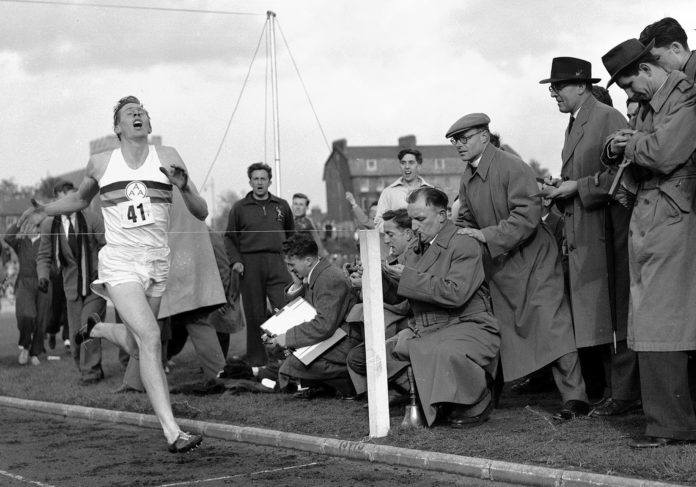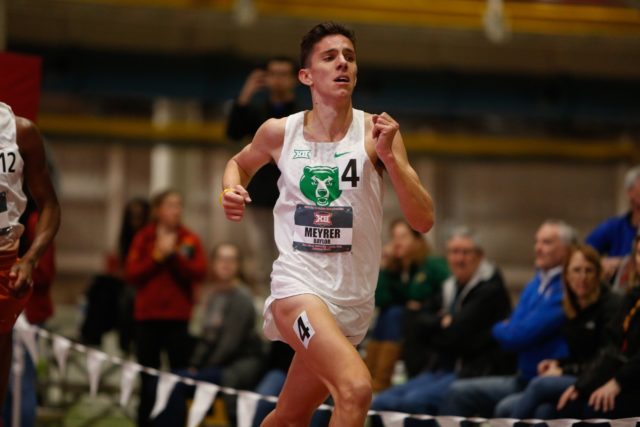
By Nathan Keil | Sports Editor
The winds were swirling all around the track on May 6, 1954, in Oxford, England. The conditions were less than ideal, but Sir Roger Bannister was not going to let the weather prevent him from making history.
Bannister walked toward the starting line at Iffley Road cinder track. As he prepared for the challenge of defying the impossible and braced for the moment he had been waiting for his entire life, Bannister had only one thing on his mind: break the four-minute mile barrier.
3:58.08 minutes later, Bannister collapsed in the arms of his supporters, celebrating his triumph and imprinting the sport of track and field forever.
Bannister described these final moments as he approached the finish line in his autobiography “Twin Tracks.”
“With five yards to go, the finishing line seemed almost to recede,” Bannister wrote. “Those last few seconds seemed an eternity. The faint line of the finishing tape stood ahead as a haven of peace after the struggle. The arms of the world were waiting to receive me only if I reached the tape without slackening my speed. If I faltered now, there would be no arms to hold me and the world would seem a cold, forbidding place. I leapt at the tape like a man taking his last desperate spring to save himself from a chasm that threatens to engulf him.”
This historical moment on the track, even though it was broken just 46 days later, is still held in high regard by the running community. Memories and inspiration of this moment have been recently dusted off as Banister died on March 3 of natural causes in his home in England, according to the New York Times. Bannister was 88-years old.
For Baylor head coach Todd Harbour, a sub-four-minute club member himself while at Baylor, and collegiate record holder with a time of 3:50:34, said Bannister’s feat is one of the greatest in all of sports.

Courtesy of Baylor Athletics
“It means he set the standard as far as one of the greatest achievements in sports was doing anything that people, scientists say is physically impossible,” Harbour said. “Physiologists and the scientists of the day said it couldn’t be physically be done and that you’d die because your heart would rupture. They said it was easier to climb Mountain Everest –– and no one had done it at that time –– than someone running a four minute barrier.”
Bannister evaded death when he crossed that Oxford tape, his accomplishment creating an allure of immortality for Bannister. No matter how fast, no man or woman can outrun time. So when news of his death spread, it had a profound impact on much of the running community, including Harbour and freshman distance runner Devin Meyrer.
“He was such a role model for so many people in the running community. I think I was one of the thousands of not hundreds of thousands that grieved his death,” Meyrer, who holds a personal record of 4:10, said. “He went down as a legend. It feels weird not to have that person here with us anymore.”
Bannister may have been the first to break the four-minute barrier, and many have done it since. But Bannister didn’t view it as an individual accomplishment. Instead, it was a team effort and Bannister was not shy about giving his teammates the recognition they deserved.
“I think in athletics, the part of the team is, that’s the part you remember,” Harbour said. “Yeah, he did this great thing, yet his teammates that ran it with him, and helped him, set the pace for him and did a beautiful job of pace setting, setting him to do it. You remember the victories and the records, but you remember the guys you spent it with and that’s what it’s all about.”
Bannister recruited friends Chris Brasher and Chris Chataway to help set the pace for him. Bannister recorded 58 seconds in the first lap, 1:58.3 after two and 3:01 after three, meaning he would have to be less than 59 seconds to set the record.
Bannister’s barrier-breaking, odds-defying, physical-championing race became a reality as he refused to believe anything it was impossible. This mindset has made way for runners to continue to push the physical boundaries on the track, including Meyrer, who is still hoping to one day join this elite four-minute club.
“I think the biggest thing is that mentality, every single day, I’m going to be the best I can be and not only that but I’m going to take a step further and be something nobody has ever been before — that is a sub-four-miler,” Meyrer said. “I think that influences runners as well as coaches just to be the best they can be no matter what.”

Courtesy of Baylor Athletics
Bannister was a trailblazer, but there are other major barrier that runners have their minds set on as well.
“Right now, the big one is the two-hour marathon,” Harbour said. “To me, that’s mind-boggling. Someone running that fast for 26 miles, I can’t fathom it. I was a runner and an elite runner, but the pace they have to run, that’s incredible.”
The closest is Kenyan Eliud Kipchoge, who fell just short with a time of 2:00:25, a pace of 4:36 per mile. As Bannister’s heroic tale in Oxford 64 years ago tells us, however, these barriers are meant to be broken.





